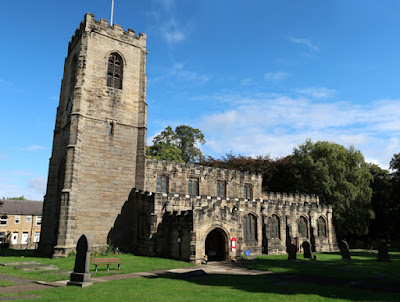A few days after my visit to Hooton Pagnell, where I visited All Saints church, photographed many historic buildings and had a good look at its geology, my next excursion by bus and train was to All Saints church in Darton, which I had first seen from the No. 96 bus on the way to the Yorkshire Sculpture Park from Barnsley.
All Saints church is set on the edge of the outcrop of the Haigh Moor Rock, with the 1854 Ordnance Survey map showing an old quarry just to the north-east of the railway station and the Darton Quarry a few hundred metres to the south-west of the church but, as shown on the Building Stones Database for England map explorer, the greatest concentration of quarries in the area was along the escarpment of the Woolley Edge Rock.
The earliest record of the church, which was built by a member of the De Lacy family of Pontefract, appears in 1150 but virtually nothing remains of this and the structure we see today was completely rebuilt between 1480 and 1517 by Thomas de Tykyll, Prior of Monk Bretton Priory. It was not restored in the Georgian or Victorian periods, which makes it one of the most complete and unaltered late Perpendicular Gothic churches in South Yorkshire.
According to the church website, it is one of 5 sister churches that share the same design, with the others being at High Hoyland, Cawthorne, Silkstone and Royston. I haven’t been to High Hoyland, which was rebuilt in the C17 and early C20, but I have seen the others and the towers are all very similar, although there are differences in the clerestory at Royston and at Cawthorne the nave and aisles look quite different, with C13 and C19 work being prominent.
Walking anti-clockwise around the exterior to take a set of general record photographs for the British Listed Buildings website, I could see that the broad four centred arches to the south aisle and the flat headed windows to the clerestory are in the late Perpendicular Gothic style. Although quite blackened in places, I could see that masonry has the light brown to rusty brown colours that are common in Coal Measures sandstone.
Taking a closer look at the east end of the south aisle, I could see that the sandstone is quite coarse grained, strongly cross-bedded, with ‘wild’ colouration from grey to rusty brown. The walling stone here contrasts with the much finer grained, laminated Coal Measures sandstone which has been used for the grave slabs that are attached to the wall.
On the east end of the chancel, I could get a much better look at the stonework and noticed that the cross-bedding and ‘wild’ colour variation is very pronounced, with graded finer iron rich sediment often concentrated along the foresets and the differential weathering of these producing quite a distinctive texture.
At the vestry, which forms an extension of the building to the east of the Lady Chapel, the very coarse texture can be appreciated close up, which can be a feature of the Woolley Edge Rock. The geological memoir describes it as massive and being sometimes coarse grained and having a closer resemblance to the Lower Coal Measures sandstones or Millstone Grit than to any of the other Middle Coal Measures sandstones.
Continuing to the north aisle, the windows are square headed, to which Pevsner assigns a later date than the south aisle, but the same variation in the physical characteristics of the coarse sandstone can be seen; however, as very often seen in the masonry on the north elevation of buildings in the UK, the damp environment attracts green and red algae and this obscures the colour variation seen in the stone, which is also quite blackened.
I had previously seen exposures of the Woolley Edge Rock in a road cutting at Worsbrough Bridge and the Burton Bank Quarry in Barnsley and, based on visits to Wakefield Cathedral, the Chantry Chapel of St. Mary, St. Helen’s church and Sandal Castle – where I have seen very distinctive 'striped' sandstone - I am inclined to think that this sandstone has been used at All Saints church and not the Haigh Moor Rock.
The masonry in the tower is much cleaner than that seen in the rest of the church, with the wild colour variation being clearly visible. Apart from the concentration of iron rich sediment along certain beds, clay ironstone pellets are also present, with many of these being weathered away to leave a void in the stone.
 |
| The west wall of the tower |
To the arch of the blocked arch at the east end of the south aisle, the square heads of the clerestory windows and the entrance to the porch, there are very weathered headstops in the form of human heads and grotesques.
The sandstone used for the fabric of the building is far too coarse grained for it to be intricately carved and, although I could not get very close to examine them, it appears that the stone used is Permian dolomitic limestone from the Cadeby Formation, which outcrops approximately 17 km to the east of Darton.
 |
| Headstops on the porch |












No comments:
Post a Comment